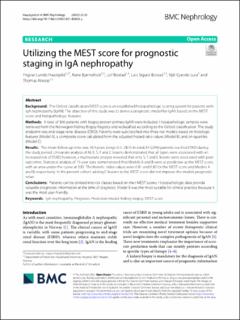| dc.contributor.author | Haaskjold, Yngvar Lunde | |
| dc.contributor.author | Bjørneklett, Rune Oskar | |
| dc.contributor.author | Bostad, Leif | |
| dc.contributor.author | Bostad, Lars Sigurd | |
| dc.contributor.author | Lura, Njål Gjærde | |
| dc.contributor.author | Knoop, Thomas | |
| dc.date.accessioned | 2022-06-07T12:40:40Z | |
| dc.date.available | 2022-06-07T12:40:40Z | |
| dc.date.created | 2022-01-12T10:43:13Z | |
| dc.date.issued | 2022 | |
| dc.identifier.issn | 1471-2369 | |
| dc.identifier.uri | https://hdl.handle.net/11250/2997731 | |
| dc.description.abstract | Background
The Oxford classification/MEST score is an established histopathologic scoring system for patients with IgA nephropathy (IgAN). The objective of this study was to derive a prognostic model for IgAN based on the MEST score and histopathologic features.
Methods
A total of 306 patients with biopsy-proven primary IgAN were included. Histopathologic samples were retrieved from the Norwegian Kidney Biopsy Registry and reclassified according to the Oxford classification. The study endpoint was end-stage renal disease (ESRD). Patients were subclassified into three risk models based on histologic features (Model A), a composite score calculated from the adjusted hazard ratio values (Model B), and on quartiles (Model C).
Results
The mean follow-up time was 16.5 years (range 0.2–28.1). In total, 61 (20%) patients reached ESRD during the study period. Univariate analysis of M, E, S, T and C lesions demonstrated that all types were associated with an increased risk of ESRD; however, a multivariate analysis revealed that only S, T and C lesions were associated with poor outcomes. Statistical analysis of 15-year data demonstrated that Models A and B were as predictive as the MEST score, with an area-under-the-curve at 0.85. The Harrel c index values were 0.81 and 0.80 for the MEST score and Models A and B, respectively. In the present cohort, adding C lesions to the MEST score did not improve the models prognostic value.
Conclusions
Patients can be divided into risk classes based on their MEST scores. Histopathologic data provide valuable prognostic information at the time of diagnosis. Model B was the most suitable for clinical practice because it was the most user-friendly. | en_US |
| dc.language.iso | eng | en_US |
| dc.publisher | BioMed Central | en_US |
| dc.rights | Navngivelse 4.0 Internasjonal | * |
| dc.rights.uri | http://creativecommons.org/licenses/by/4.0/deed.no | * |
| dc.title | Utilizing the MEST score for prognostic staging in IgA nephropathy | en_US |
| dc.type | Journal article | en_US |
| dc.type | Peer reviewed | en_US |
| dc.description.version | publishedVersion | en_US |
| dc.rights.holder | Copyright 2022 The Author(s) | en_US |
| dc.source.articlenumber | 26 | en_US |
| cristin.ispublished | true | |
| cristin.fulltext | original | |
| cristin.qualitycode | 1 | |
| dc.identifier.doi | 10.1186/s12882-021-02653-y | |
| dc.identifier.cristin | 1979168 | |
| dc.source.journal | BMC Nephrology | en_US |
| dc.identifier.citation | BMC Nephrology. 2022, 23, 26. | en_US |
| dc.source.volume | 23 | en_US |

